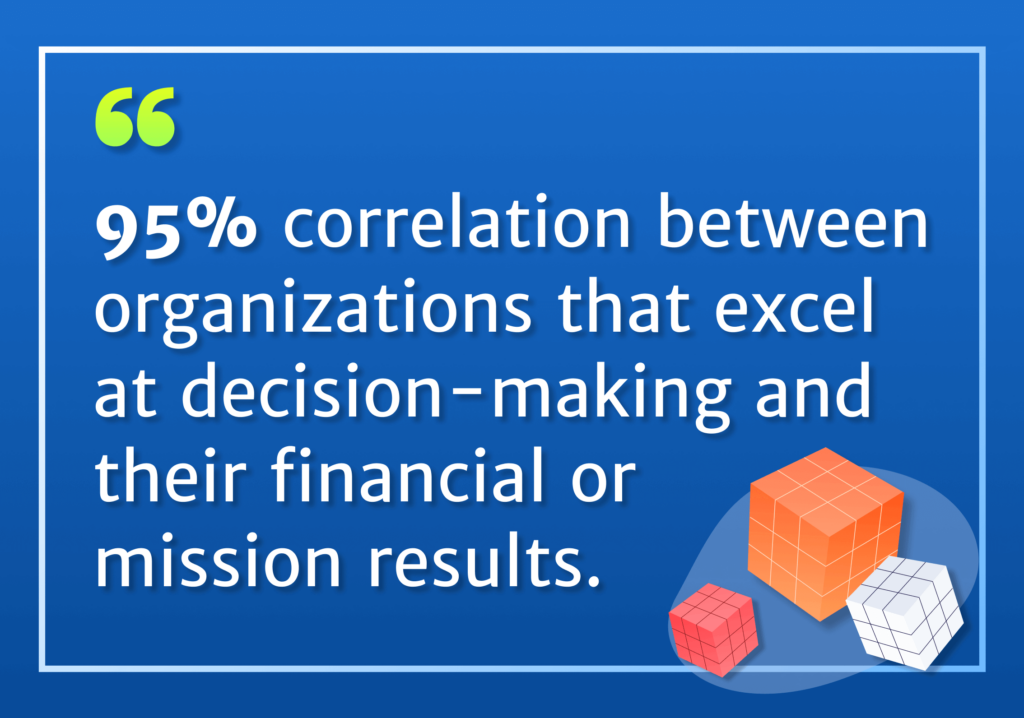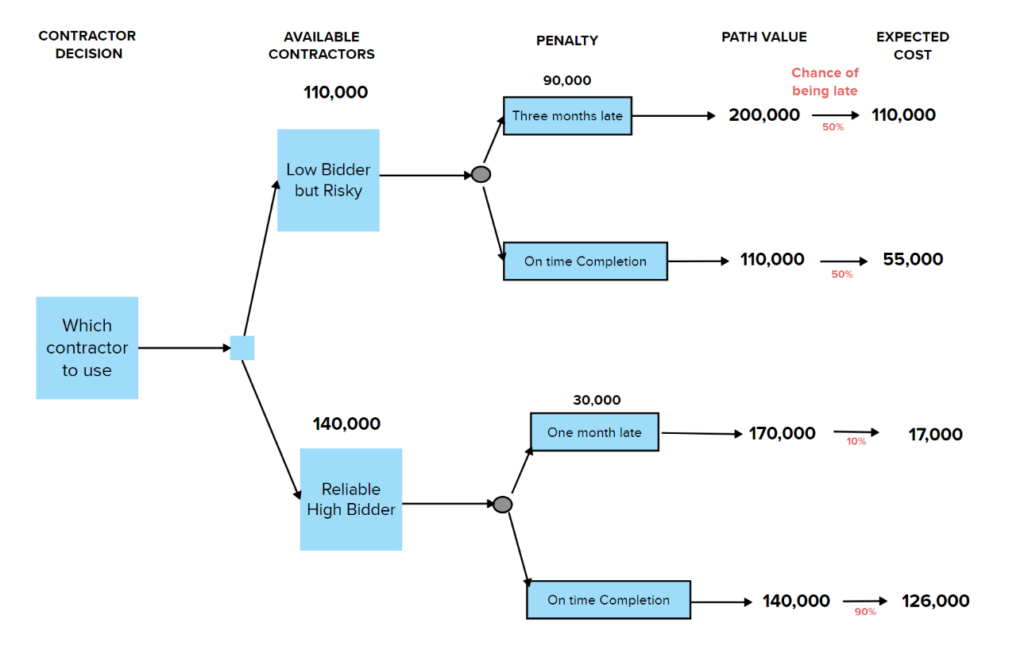Robust Instrument: How Decision Tree Framework Helps Consultants
Blog Categories:
Published:
October 7, 2023
Reading Time:
6 minutes

As human beings, we make hundreds of decisions every day. It’s an average of 122 choices, to be exact. Many spend long hours deciding where to eat, what to wear, and which route to go to work.
In the business context, the decisions made are at a much higher level and can affect the whole firm’s operation, performance, goals, and future. The more senior role one takes, the more “visible, impactful and scrutinized” their decisions will be, Forbes said.
Business leaders often spend a great amount of time making decisions. McKinsey research revealed that executives use an average of 40% of their time for decision-making. Many even struggle with decisions so much that they suffer a phenomenon called “decision fatigue”, the paper said.
When there are so many decisions that need to be made and they are all important not to be overlooked, it is important to have a structured framework to assist the decision-makers.
In this blog, we introduce you to the world of the decision tree framework. This approach has been used widely in decision-making processes, and other fields like Artificial Intelligence and psychology.
In the business context, this tool helps executives and consultants explore, evaluate, and select the best option for a firm.
In the business context, the decisions made are at a much higher level and can affect the whole firm’s operation, performance, goals, and future. The more senior role one takes, the more “visible, impactful and scrutinized” their decisions will be, Forbes said.
Business leaders often spend a great amount of time making decisions. McKinsey research revealed that executives use an average of 40% of their time for decision-making. Many even struggle with decisions so much that they suffer a phenomenon called “decision fatigue”, the paper said.
When there are so many decisions that need to be made and they are all important not to be overlooked, it is important to have a structured framework to assist the decision-makers.
In this blog, we introduce you to the world of the decision tree framework. This approach has been used widely in decision-making processes, and other fields like Artificial Intelligence and psychology.
In the business context, this tool helps executives and consultants explore, evaluate, and select the best option for a firm.
Decision Tree Framework and Its Components
A decision tree framework can be defined as a visual description of a decision problem. It provides a clear and documentable framework for the decision-making process.
With this tool, consultants can visualize available options and courses of action/outcomes that follow. They can also calculate and add the expected value/cost to each available alternative.
The tree-shaped diagram provides users with a clear picture of different options and their risks and rewards, from which they can make a sound decision.
As its name may indicate, this framework simply looks like a tree with trunks and branches.
Consultants can simply draw their decision trees by hand on a piece of paper or whiteboard. For more sophisticated issues and decisions, they may need to use decision tree software. There are many templates and tools on offer for one to choose from.

With this tool, consultants can visualize available options and courses of action/outcomes that follow. They can also calculate and add the expected value/cost to each available alternative.
The tree-shaped diagram provides users with a clear picture of different options and their risks and rewards, from which they can make a sound decision.
As its name may indicate, this framework simply looks like a tree with trunks and branches.
- The main trunk features the decision that needs to be made.
- Each main branch represents an option, which is part of the decision-making process.
- Smaller branches portray expected outcomes or consequences.
Consultants can simply draw their decision trees by hand on a piece of paper or whiteboard. For more sophisticated issues and decisions, they may need to use decision tree software. There are many templates and tools on offer for one to choose from.

KEY TAKEAWAYS
- A visual instrument can be immensely helpful for business executives and consultants who have to spend a great portion of their time on decision-making tasks.
The Anatomy of Decision Tree Framework
Experts believe that the decision tree concept was first introduced as a decision-making tool in the 1960s.
In his article about the decision tree framework in the Havard Business Review in 1964, John F. Magee, then chairman of the board of directors of Arthur D. Little, said this tool gave management the chance to review options with “greater ease and clarity”.
He argued that this tool, though did not offer final answers to the decision in the light of uncertainty, was especially helpful in presenting investment structure decisions and evaluating capital investment opportunities.
The use of decision trees in Artificial Intelligence and Statistical Analysis was introduced a bit earlier than that. According to the History of Data Science, the origins of decision trees in machine learning algorithms can be traced back to Ronald Fisher’s paper on discriminant analysis.
Starting from the 20th century, the decision tree method was also used to model the human concept of learning in psychology.
Nowadays, the decision tree is still widely recognized as a “robust” decision scaling approach. It is also a popular machine-learning algorithm that can be used for both regression and classification tasks.
In his article about the decision tree framework in the Havard Business Review in 1964, John F. Magee, then chairman of the board of directors of Arthur D. Little, said this tool gave management the chance to review options with “greater ease and clarity”.
He argued that this tool, though did not offer final answers to the decision in the light of uncertainty, was especially helpful in presenting investment structure decisions and evaluating capital investment opportunities.
The use of decision trees in Artificial Intelligence and Statistical Analysis was introduced a bit earlier than that. According to the History of Data Science, the origins of decision trees in machine learning algorithms can be traced back to Ronald Fisher’s paper on discriminant analysis.
Starting from the 20th century, the decision tree method was also used to model the human concept of learning in psychology.
Nowadays, the decision tree is still widely recognized as a “robust” decision scaling approach. It is also a popular machine-learning algorithm that can be used for both regression and classification tasks.
Why Consultants Need Decision Tree Framework
One of the core roles of management consultants is to help clients evaluate important choices and make decisions to solve critical problems. At many points, consultants may feel torn between two options, let's say, a high-risk low-cost choice versus a low-risk high-cost option.
The decisions they make or advise can be translated to success or failure. A survey by Bain and Company pointed out a 95% correlation between organizations that excel at decision-making and their financial or mission results. This literally means that the better decision they make, the more they earn.

Here at Consultport, visual frameworks like decision trees are of immense help to our consultants in achieving structured decision-making.
This tool helps professionals better organize their thoughts and analysis to arrive at the best decision for their clients.
This powerful tree lays out all options and their expected consequences for consultants to make critical analyses and informed evaluations. Specifically, users can measure the value of outcomes and the feasibility of achieving them.
Depending on the areas consultants are working on, they can use this framework for a variety of choices that need to be made. It can be a feasible market for an expansion plan, a new supplier, an innovation agenda to focus on, and a business model that is the most suitable for the client firm.
The decisions they make or advise can be translated to success or failure. A survey by Bain and Company pointed out a 95% correlation between organizations that excel at decision-making and their financial or mission results. This literally means that the better decision they make, the more they earn.

Here at Consultport, visual frameworks like decision trees are of immense help to our consultants in achieving structured decision-making.
This tool helps professionals better organize their thoughts and analysis to arrive at the best decision for their clients.
This powerful tree lays out all options and their expected consequences for consultants to make critical analyses and informed evaluations. Specifically, users can measure the value of outcomes and the feasibility of achieving them.
Depending on the areas consultants are working on, they can use this framework for a variety of choices that need to be made. It can be a feasible market for an expansion plan, a new supplier, an innovation agenda to focus on, and a business model that is the most suitable for the client firm.
Decision Tree Framework Application in Consulting
Business leaders often spend a great amount of time making decisions. According to McKinsey research, executives use an average of 40 percent of their time for decision-making. Many struggle with decisions so much that they suffer a phenomenon called “decision fatigue”, the paper said.The decision tree framework can be an exceptional tool for consultants to help clients with making operational, tactical, and strategic decisions:
- Operational decisions are short-term and focus on routine activities of the business. Known as the backbone of every business, operational decisions can range from equipment purchase and inventory management to store layout and customer loyalty program development.
- Tactical decisions are medium-term and concentrate on achieving the business’s objective. They are breaking strategic plans into concrete actions. Examples include pricing strategy, marketing campaign, as well as distribution channel and production planning activities.
- Strategic decisions are more about long-term strategies that will have an impact on the entire organization in the long run. These decisions are related to the direction, visions, goals, and policies of the firm. It can be the expansion of the market, large investment in research and development, merging and acquisition as well as diversifying product and service ranges.
Step-by-step Guideline in Decision Tree Analysis
Making decisions can be a challenging task for many, but it would be way easier to follow a step-by-step guideline for a decision tree framework. In his paper, David T. Hulett suggested the following steps to take before arriving at a decision:- Identify the decision that needs to be made (decision nodes) and uncertainties (event nodes) related to the consequences.
- Visualize the trees (with the decision and all major consequences). Each decision or event node has at least two options with the branches on the right.
- Estimate the costs and benefits of each option. This is an important task as the estimates serve as a foundation that one will rely largely on to make decisions.
- Calculate the value of the project for each path.
- One sub-contractor is lower-cost ($110,000 bid). It is estimated that there is a 50% chance that this contractor will be 90 days late and the contract with the main client specifies that the company must pay a delay penalty of $1,000 per calendar day for every day the company delivers late.
- The higher-cost sub-contractor bids $140,000. This contractor poses a low 10% chance of being late, and only 30 days late at that. The customer will impose the same $1,000 delay penalty per day for late delivery.

The expected cost of “Low Bidder but Risky” and “Reliable High Bidder” are $165,000 and $143,000 respectively. Depending on the judgment and analysis of business leaders and consultants, this diagram can be an excellent source of reference for them to make decisions.
Conclusion
Making a decision is not merely choosing the best out of many options. A good decision-maker builds higher trust and exerts a positive influence on how they are perceived as a leader.
To achieve a new level of structured decision-making, our talented consultants with exceptional expertise and professional experience have constantly updated themselves with the latest effective tools and methodologies to ensure the delivery of world-class services to our clients.
If you want to become part of this talented pool, don’t hesitate to contact us!
To achieve a new level of structured decision-making, our talented consultants with exceptional expertise and professional experience have constantly updated themselves with the latest effective tools and methodologies to ensure the delivery of world-class services to our clients.
If you want to become part of this talented pool, don’t hesitate to contact us!
Share This Story, Choose Your Platform!



